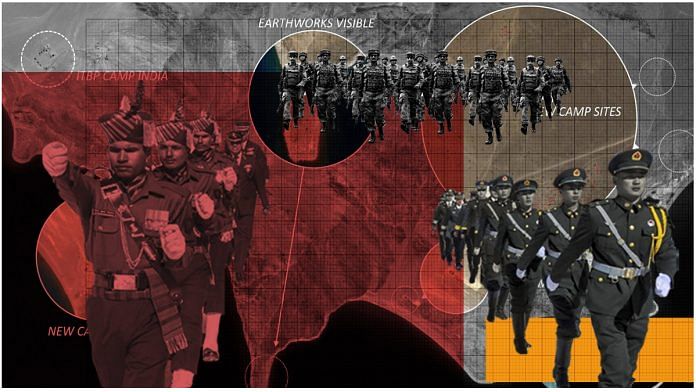New Delhi: A “befitting reply” to Chinese actions in the Galwan Valley, as talked about by Prime Minister Narendra Modi, doesn’t necessarily mean “it is going to be only in the military domain, it could also be economic or diplomatic”, according to retired General S.L. Narasimhan, member of India’s National Security Advisory Board (NSAB).
In an interview with ThePrint, Gen. Narasimhan talked about the various aspects of the on-going military stand-offs between India and China.
“Even if you go by the claim lines put out by China in 1960, the Galwan Valley is our territory,” said the General. However, the Chinese foreign ministry, which put out a statement Friday detailing their account of last week’s violent face-off, said the Galwan Valley was on China’s side of the Line of Actual Control (LAC).
When asked about any Indian soldiers missing from after the clashes, Gen. Narasimhan said, “Officially, we don’t know…We need to wait and watch. If there are further people missing, official communications will come.”
The NSAB member said that from the Indian perspective, the bottom line is that the “status quo ante” needs to be restored.
“The Chinese need to go back to locations they were holding before the month of May. Character of the LAC (Line of Actual Control) would not change unilaterally, even if they try, they won’t succeed,” remarked the general.
Also read: India uses AIR Chinese service to broadcast commentary on Galwan ‘transgression’ by China
Indian options going ahead
The NSAB member clearly stated that military action against China was definitely the last option.
When asked to elaborate on Prime Minister’s remark regarding India’s ability to provide a befitting reply when provoked, he said, “Military option is the last option. We need to exhaust all other options that are available to us before we go down that path. And I think there is still space available before we take a call about that (military action).”
According to Narasimhan, the “available space” means that when responding to Chinese aggression, India has a lot of options. He said India has diplomatic, ground level, foreign minister related options available.
“There are a lot of other military options as well, (which are) not in the kinetic domain that I would not like to talk about,” he said.
Also read: Army rubbishes media claims of 20 Indian soldiers missing in Galwan valley
Events at Galwan were ‘pre-meditated’
According to the NSAB member, at the lieutenant general-level talks that took place on 6 June, a “consensus was arrived” that “disengagement would take place”.
Moreover, at the places where these face-offs are taking place, it was decided that further discussions would take place to discuss the “modalities of disengagement process”.
But the Chinese went back on the 6 June agreement to facilitate disengagement, according to Narasimhan.
“On the evening 15th June, as a unit of Bihar Regiment patrol went to see if disengagement process was on (at the LAC in Galwan Valley) … they found probably a structure kind of thing built by Chinese on the Indian side. When the Indian side asked them to go back, they did. But then they came back and that’s when the scuffle seems to have taken place,” he said.
The general further elaborated on Minister of External Affairs S. Jaishankar’s statement to his Chinese counterpart, that the action by People’s Liberation Army forces at Galwan Valley was “pre-meditated”.
“When Chinese went back and came back again, that indicated that it was premeditated action,” he explained. “I think they wanted to ensure that particular place is with them. Given that didn’t happen, that must have upset their plan and they decided to come back.”
Here Narasimhan is referring to how the Bihar Regiment patrolling forces had pushed back PLA troops on 15th June evening, but the latter decided to come back again.
‘Casualties would have been higher if there was firing’
In terms of the nature of violence between the two sides, Narasimhan said, “the level of violence seems to be varying between pushing and pulling and less than opening firing”.
“It happened sometime in the evening. Some stone pelting had taken place and batons were used. What I can say for sure is there was no firing. If there was firing, casualties would be even higher,” he said.
When talking about Chinese casualties, he said that he was certain the Chinese side had suffered casualties, but it was not possible to know the exact numbers.
When pressed to provide a ballpark figure, Narasimhan said, “I get a feeling it would be around the same number as our side or little more than that. It is possible that they suffered more.”
Also read: China has an Achilles’ heel. India must take the battle there from LAC
Galwan different from recent Chinese aggressive behaviour
As the general tried to analyse how the current standoff was different from the ones in the past, he listed four points of departure.
“It is happening simultaneously at multiple places. What is happening can’t be attributed to a local commander this time. Their numbers are much larger than before. And the aggressiveness is also more than the previous time,” explained Narasimhan.
When the NSAB member — who also speaks Mandarin and is a close observer of Chinese behaviour — was asked about what explains the recent aggressive Chinese behaviour, he pointed towards a pattern.
“This aggressive behaviour with China has been around for some time. Look at what they are doing in South China Sea, look at the aid they are front loading to cover their initial mishandling of the pandemic,” Narasimhan said.
He said this behaviour could be explained by the comprehensive growth in China’s national power and the country is now trying to spread its influence across the board.
Also read: India working to restrict Chinese goods, investments since before Galwan, Covid: Officials



